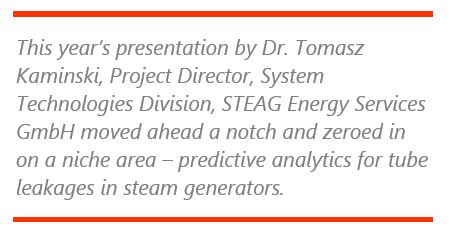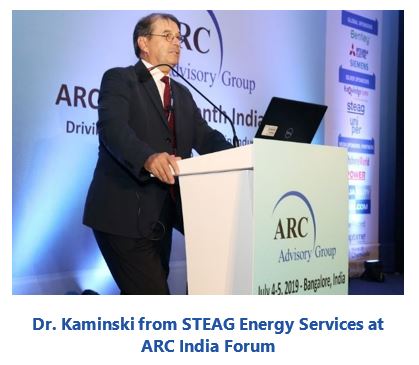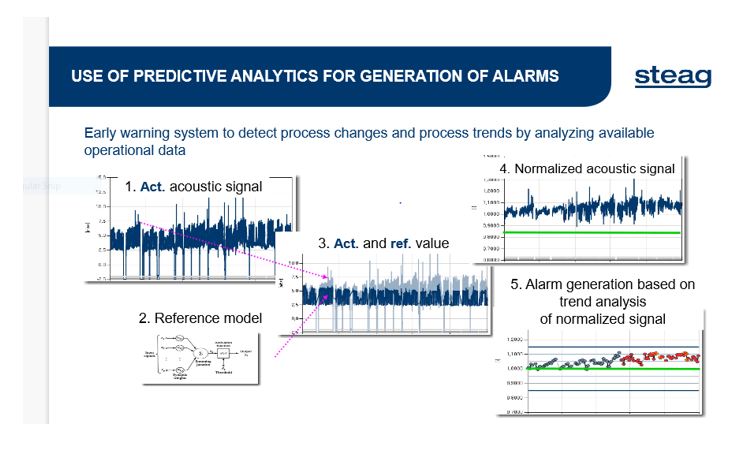

Once again at this year’s ARC India Forum, Silver Sponsor, STEAG Energy Services, a subsidiary of Germany’s STEAG Group, provided a thought-provoking presentation on how new innovative software solutions can be used to improve asset performance in global power plants. The STEAG Group - with 
Last year, the focus of the joint presentation by the company’s representatives was on “flexibilization” - the company’s multi-pronged approach to systems, processes, and procedures that efficiently merge conventional and renewable power in the power grids. This year’s presentation by Dr. Tomasz Kaminski, Project Director, System Technologies Division, STEAG Energy Services GmbH moved ahead a notch and zeroed in on a niche area – predictive analytics for tube leakages in steam generators. Dr. Kaminski and his team develop, commission, and maintain IT solutions for power plants in the flexibilization scenario.
Key takeaways:

In India, companies like NTPC have installed the company’s systems mainly to monitor the efficiency of their units. With flexibilization, companies in the power sector can have lifetime monitoring. Operator training simulators, thermodynamic tools, and distribution and transmission simulators help streamline processes and reduce costs drastically, he said.
Moving on to the focus of his presentation, Dr. Kaminski showed a cross-section of a boiler with many heating surfaces and tubes that extend over kilometers. The tubes have to withstand the heat from the flue gas, created by burning coal, and transport this to the steam generator. Statistics show that, annually, there are between 2 to 10 tube leaks per unit, making tube failure a common cause of loss of availability of power. At any point a tube leakage can occur, severely impacting power plant operations and causing unplanned shutdowns. To prevent secondary damages on pressure parts like water wall tubes, superheater tubes, and reheater tubes, the operating engineers constantly have to watch out for leakages. The costs incurred by consequential damage can be very high as the repairs take time - this means losses in the sale of the generated electricity.
The main causes of tube leakages are overheating, defective welds, erosion, and internal corrosion. According to Dr. Kaminski, the best approach is to avoid tube leakages in the first place; but due to wear and tear, this is not always possible, he said. The standard approach is to evaluate the sound coming from the tube via sound sensors; the microphone should detect this whistle, and the computer must set off the alarm. Acoustic leakage detection has many challenges – false alarms, time-consuming checks by experts, consequential delays and damages. Next, he spoke about the company’s predictive analytics solution, substantiated by case studies.
In this context, Dr. Kaminski showcased the efficacy of ALMA, the company’s advanced leakage monitoring and alerting tool for alarm generation. New trends and applications are emerging in this space, he said. For instance, based on the sounds generated and the environment, a digital twin can be created with a neural network, which will generate a reference sound value and detect anomalies.

Case studies show comparison between alarming by three methods used by power plant operators where predictive analytics method has been installed:
Leakage of superheater tubes; leakage of reheater tubes; and incipient damage of superheater tubes.
These problems were resolved by continuous condition monitoring and boiler leakage detection through predictive analytics. The following benefits were achieved: relief of the operating personnel during the ongoing evaluation of the microphones' data and cost savings through avoidance of boiler trips, avoidance of major consequential damage, and shorter repair downtimes.
The advantages of deploying predictive analytics to detect tube leakages are:
Dr. Kaminski’s presentation at the ARC India Forum effectively showed how implementing predictive analytics in the power generation sector provides an early warning system to detect process changes and trends by analyzing available operational data. New approaches in the power sector, such as flexibilization, operator training simulators, and digital twins are streamlining industrial processes and improving operational efficiency. The case studies he provided make it clear that STEAG has made significant headway in this direction.
ARC Advisory Group clients can view the complete report at ARC Client Portal
If you would like to buy this report or obtain information about how to become a client, please Contact Us
Keywords: STEAG, ARC India Forum, Predictive Analytics, Tube Leakages, ALMA, ARC Advisory Group.

